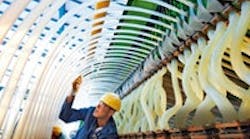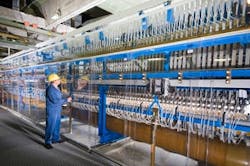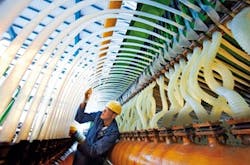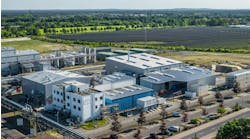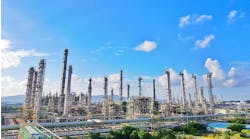Electrochemical chlorine production currently is one of the most energy-intensive processes in the chemical industry. However, a new way of manufacturing chlorine — using oxygen depolarized cathode (ODC) technology — can reduce power consumption by as much as 30% compared to standard membrane technology, with a corresponding cut in indirect carbon dioxide emissions.
The process integrates the cathodic fuel cell reaction of oxygen reduction into the membrane electrolysis that produces chlorine from salt. By feeding in gaseous oxygen, the technology enables electrolysis to be performed at a lower voltage.
The new process incorporates oxygen depolarized cathodes developed by Bayer MaterialScience into electrolysis cell technology of ThyssenKrupp Uhde, Dortmund, Germany. Bayer MaterialScience is a major global producer of chlorine, with a total annual capacity of around 1.9 million metric tons at four sites in Germany and one each in the U.S. and China. ThyssenKrupp Uhde is one of the world's leading electrolysis cell manufacturers and chlorine plant suppliers. The two companies are collaborating on the large-scale testing of the process, and expect to offer the technology to chlorine manufacturers shortly.
LARGE-SCALE TRIAL
A demonstration plant with an annual capacity of 20,000 metric tons of chlorine went on-stream in mid-2011 at Chempark Krefeld-Uerdingen, Germany (Figure 1). The two companies initiated the ODC demonstration plant project in cooperation with three German universities: RWTH Aachen University, Aachen, Clausthal University of Technology, Clausthal-Zellerfeld, and Dortmund University, Dortmund. The German Federal Ministry of Education and Research provided funding under its research for sustainability program.
Assuming the trial is successful, Bayer MaterialScience intends to gradually switch parts of its chlorine production to the new process. Other large German chlorine producers and companies across Asia Pacific already have expressed their interest.
Bayer MaterialScience has been using the ODC technology for chlorine production from hydrochloric acid at the Bayer Integrated Site Shanghai in China and at Brunsbüttel in Germany (Figure 2). The company recently completed converting all its salt-electrolysis mercury cells to membrane technology; European chlorine manufacturers have made a voluntary commitment to discontinue the outdated mercury process by 2020.
ECOLOGICAL EMPHASIS
"ODC is yet another example of our focus on developing new solutions for tackling climate change," says Tony Van Osselaer, a member of the Bayer MaterialScience board of management.
"It is important for us to adopt a holistic approach, and that is why we are also offering the oxygen depolarized cathode to other companies for eco-friendly chlorine production. The more CO2 emissions we can prevent across the globe, the better."
Through model calculations, experts have estimated that use of the technology by chlorine producers in Germany would save enough electricity to power a city with more than one million inhabitants. This corresponds to the electricity generated by a 700-MW power plant.
"As a technology company, we are always looking for solutions that offer our customers economic and ecological benefits. NaCl oxygen depolarized cathode technology has the potential to offer just such a solution," notes Sami Pelkonen, head of the electrolysis division at ThyssenKrupp Uhde.
UTE MÜLLER-EISEN handles communications for the basic chemicals group of Bayer MaterialScience, Leverkusen, Germany. JUERGEN KINTRUP is responsible for ODC technologies at the basic chemicals group of Bayer MaterialScience in Leverkusen. E-mail them at [email protected] and [email protected].
